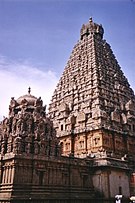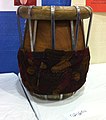Ancient Tamil music
This article includes a list of general references, but it lacks sufficient corresponding inline citations. (July 2020) |

| Part of a series on |
| History of Tamil Nadu |
|---|
 |
| Indian classical music |
|---|
 |
| Concepts |
| Topics in Sangam literature | ||
|---|---|---|
| Sangam literature | ||
| Agattiyam | Tolkāppiyam | |
| Eighteen Greater Texts | ||
| Eight Anthologies | ||
Aiṅkurunūṟu |
Akanāṉūṟu
| |
Puṟanāṉūṟu |
Kalittokai | |
| Kuṟuntokai | Natṟiṇai | |
| Paripāṭal | Patiṟṟuppattu | |
| Ten Idylls | ||
| Tirumurukāṟṟuppaṭai | Kuṟiñcippāṭṭu | |
| Malaipaṭukaṭām | Maturaikkāñci | |
| Mullaippāṭṭu | Neṭunalvāṭai | |
| Paṭṭiṉappālai | Perumpāṇāṟṟuppaṭai | |
| Poruṇarāṟṟuppaṭai | Ciṟupāṇāṟṟuppaṭai | |
| Related topics | ||
| Sangam | Sangam landscape | |
Tamil history from Sangam literature |
Ancient Tamil music | |
| Eighteen Lesser Texts | ||
| Nālaṭiyār | Nāṉmaṇikkaṭikai | |
| Iṉṉā Nāṟpatu | Iṉiyavai Nāṟpatu | |
| Kār Nāṟpatu | Kaḷavaḻi Nāṟpatu | |
| Aintiṇai Aimpatu | Tiṉaimoḻi Aimpatu | |
| Aintinai Eḻupatu | Tiṇaimālai Nūṟṟaimpatu | |
Tirukkuṟaḷ |
Tirikaṭukam | |
| Ācārakkōvai | Paḻamoḻi Nāṉūṟu | |
| Ciṟupañcamūlam | Mutumoḻikkānci | |
| Elāti | Kainnilai | |
| Bhakti Literature | ||
| Naalayira Divya Prabandham | Ramavataram | |
| Tevaram | Tirumuṟai | |
| edit | ||
The ancient Tamil music is the historical predecessor of the Carnatic music during the Sangam period spanning from 500 BCE to 200 CE.[1]
Many poems of the classical
Music was an integral part of the compositions of the Tamil Saiva saints such as
Sangam music
The Sangam age grammatical work
Musical instruments
Poems of the Sangam literature contain numerous mentions of the various musical instruments such as the Seerkazhi, a stringed instrument of the
The
The Murasu, or the drum was the most popular percussion instrument. During festivals, the sound of Murasu conveyed joy and gaiety. Muzhavu, another percussion instrument accompanied singers. The drum was also used as the war-drum, calling people to arms.
List of Musical instruments used by ancient
Musical notations
In Tamil music, the
Moods
Raga, which defines the mood of the Indian classical music was described by the Pann. Specific panns were sung during worship and during religious and royal ceremonies. Maduraikanchi refers to women singing Sevvazhi pann to invoke the mercy of God during childbirth. In Tolkappiyam, the five landscapes of the Sangam literature had an associated Pann, each describing the mood of the song associated with that landscape.
The Sangam landscape was classified into five regions to describe the mood of the poem and to describe the intangibles of human emotions. While describing life and romance, the poets employed the background of the natural landscape and used the pann specific to that landscape to provide the mood. The neithal landscape, which is employed to convey the grief of separation of lovers had the associated sevvazhi pann expressing pathos.
Post-Sangam music
"The south Indian music system, which was indeed Tamil Pannisai, was erroneously named, for the first time, Karnataka sangeetham in the 12th century by a western-Chalukya king, Someswara Bhuloka Mamalla, in his ‘Manasoullasam', a monumental work that dealt with all the subjects under the sun, including music. In no other language in India, there existed at that time Sahityas (musical compositions) as they did in Tamil. Though most of the music manuals written from the 9th century onwards were in Sanskrit, the source materials for them — like the varieties of ‘ragas' ( pann) they had mentioned in their works — were all associated with the Tamil literary works, like ‘Silappadikaram', ‘Thevaram', and ‘Nalayira Divya Prabhandam'.."[4]
- Tamil scholar, Mu. Arunachalam in his book Tamizh Isai Ilakkiya Varalaaru.
Evolution of panns
The post-Sangam period, between the third and the fifth centuries CE, Tamil music evolved to a different level of sophistication. Cilappatikaram, written around the fifth century CE, describes music based on logical, systematic and scientific calculations in the arrangements of the dancers on the stage to represent the notes and panns. Cilappatikaram contains several chapters dedicated to music and dance, of which the most famous is the kanal vari which is a duet between the hero
Mullaippann further evolved into Sempaalai, a scale based on seven notes. The ancient Tamils also derived new panns by the process of modal shift of tonic and by the process of reallocating the pitch and beat of the notes. Cilappatikaram has an example of this in the chapter Arangetrukadai, where the Pann Mercharupalai is changed to derive a new Pann. The four original panns of maruthappann, kurinchippann, sevvazhi and sadari thus evolved into 103 panns with varying characterisations. Some of the panns and their equivalent Carnatic ragas were:
- Panchamam – Ahiri
- Pazham Panchuram - Sankarabharanam
- Meharahkkurinchi - Neelampari
- Pazhanthakka Ragam - Arabhi
- Kurinchi - Malahari
- Natta Ragam – Panthuvarali
- Inthalam - Nathanamakriya
- Thakkesi - Kambhoji
- Kausikam - Bhairavi
- Nattappadai – Gambheeranaattai
The Important Modes of Tamil Music are grouped as Seven Great Modes (Ezh Perum Paalai). From them, 2 Modes are removed and remaining 5 are employed in Tolkappiam, there they are mentioned as Yaazh instead of Paalai or Pann which is meant to denote Musical Scale or Raaga. Also the 5 Small Modes of Tamil are derived from those 5 Great Modes. All of them are listed below, along with their Western and Carnatic equivalents :- (This doesn't mean that these Systems predate Tamil Music System.).
| 7 Great Modes / Heptatonics | 5 Tinai Tolkappiam | Eq. Carnatic Raga | 7 Western Modes | Western Scales | 5 Small Modes / Pentatonics | Eq. Carnatic Raga | Eq. Western Scales |
|---|---|---|---|---|---|---|---|
| SemPaalai | Mullai | Harikambodhi | Mixolydian | MullaitheemPaaNi | Mohanam | Major Pentatonic | |
| PadumalaipPaalai | Kurinji | Natabairavi | Aeolian | Minor Scale | Sendhurutti | Madhyamavati | Egyptian_Suspended |
| SevvazhipPaalai | --- | Todi with 2 Ma | Locrian | --- | --- | --- | |
| ArumPaalai | Paalai | Sankarabaranam | Ionian | Major Scale | Konrai | Suddha Saveri | Blues Major |
| KOdipPaalai | Marudham | Karaharapriya | Dorian | Aambal | Suddha Dhanyasi | Minor Pentatonic | |
| ViLaripPaalai | Neidhal | Todi | Phrygian | Indhalam | Hindolam | Blues Minor | |
| MerchemPaalai | --- | Kalyani | Lydian | --- | --- | --- |
The 7 Mode Set is self generative, with the 1st Mode, if we apply a method called Kural Thiribu or PannupPeyarttal (which is Tonic Shift, or Rotation), we will get the rest of 6 Modes. The Last mode will yield back the 1st Mode, its Cyclic in same order. Same applies for the 5 Pentatonic Scale set, too. The English Term 'Tonic Shift' is 1st coined by one Mr. VPK sundaram who was an important Tamil-Music Theorist and author of several Books and Articles in this topic. He coined the term in his book, Pancha Marabu, in 1991(Page 3).
Musical instruments
Cilappatikaram makes reference to five types of instruments: Tolkaruvi (lit. 'skin instruments' = percussion), Tulaikaruvi (lit. 'holed instruments' = wind instruments), Narambukaruvi (stringed instruments), Midatrukaruvi (vocalists) and Kanchakaruvi (gongs and cymbals). The flute and the yaazh were the most popular instruments, while there were numerous kinds of percussion instruments suited for various occasions. Cilappatikaram also contains detailed instructions on the art of tuning and playing the yaazh.
Devotional period
Between the fifth and the sixth centuries the Tamil literature was dominated by a moralistic age during which a number of literary works of didactic nature were produced. These poets did not attach much importance to music in their compositions, being more concerned with ethics and morals of the people. However the underlying musical culture was not forgotten. For example,
Tevaram
Tamil music revived with the advent of the Saiva and
The traditional of religious singing continued for many centuries during which singers known as Othuvars sang the Tevaram songs in temples. The musical knowledge and skills were orally passed on through generations.
Thiruppugazh
In the fifteenth century poet Arunagirinathar composed a series of poems known as
Gallery
-
Parai attam
-
Parai attam
See also
- Sangam literature
- Tamil literature
- Tamil music
- History of Tamil Nadu
- Carnatic music
- Dance forms of Tamil Nadu
- Naattupurapaattu
- Pancha Marapu
References
- ISBN 978-81-246-0538-7.
- ^ a b "Tamil Music". www.carnatica.net. Retrieved 11 February 2019.
- ^ "Ancient music instruments mentioned in thirumurai" திருமுறை குறிப்பிடும் இசைக்கருவிகள். Shaivam. Archived from the original on 3 March 2016.
- ^ Parthasarathy, Indira (1 February 2011). "Call it by any name, it is 'Tamil Isai'". The Hindu. Retrieved 2 July 2020.



























